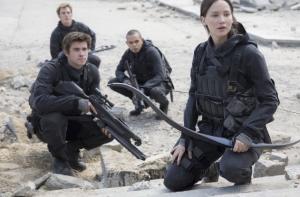‘Mockingjay, Part 2’ is war movie, plain and simple
While it may be classified as “science fiction” or even “young-adult fantasy,” make no mistake, “The Hunger Games: Mockingjay, Part 2” is a war movie, plain and simple.
The fourth and final installment of the highly successful “Hunger Games” franchise brings closure to the series, but not before many more lives are senselessly lost and an even-darker pall is cast over the ever-dwindling number of survivors as Katniss (played by Jennifer Lawrence) inevitably winds her way to the capitol steps to confront the tyrannical President Snow (played by Donald Sutherland).
It’s only fitting that the conclusion of the “Mockingjay” tale comes with such a resonant meditation of the effects of battle, as Suzanne Collins, the author of the books on which the franchise is based, was herself a military brat, often traveling with her father in the Air Force where she would witness firsthand war’s aftermath.
And while, as a whole, the saga may have suffered from a bloated conclusion (which had more to do with marketing than it did for any artistic merit), the final stretch is one that was worth the wait.
Beginning essentially on the heels of the “Part 1,” Katniss awakens after almost being choked to death by her former childhood friend Peeta (played by Josh Hutcherson). Peeta is captured and “de-programmed” after his Capitol brainwashing, and must slowly learn to trust those around him in the rebellion.
Aima Coin (played by Julianne Moore) is still leader of the resistance and decides that despite Katniss’ injuries, the young, reluctant fighter should still be used for propaganda in Coin’s crusade to overthrow Snow. But despite her scripted orders, Katniss decides that only she can bring resolution to the turmoil by assassinating Snow on her own -- not as part of some organized militia.
So into the lion’s den she goes, with her faithful followers in tow, including the still-questionable Peeta and her still-devoted boyfriend Gale (played by Liam Hemsworth). The majority of the film floats between the team’s tactical efforts through the booby-trapped streets and the quiet moments of reflection in between.
And this is where it was such a wise decision to have Lawrence in the lead, as she wholly commits to the role and shows us the mental scars that she has endured throughout her unending battles. Lawrence has always elevated the series, even when it momentarily drug its heels dramatically. But here she shoulders almost the entire film, which, in turn, brings out series-best performances from Hemsworth and Hutcherson.
Sure, there are a few flaws still to be found within (Hemsworth exits with a shrug and Stanley Tucci is but a hologram here -- literally), but where loss is truly felt is through no fault of the film, and that is with Phillip Seymour Hoffman, who played communications expert Plutarch Heavensbee. Hoffman, of course, died before filming his final scenes, and a concluding scene Katniss shares with her mentor Haymitch (played by Woody Harrelson) seems as though it could have been all the more emotionally resonant had Hoffman been alive to film it. But that does not take away from the overall message of the film(s) as to the perpetual state of war: how it tills the land for the seeds of apathy from which protest grows, ultimately to bloom into war all over again. “Mockingjay, Part 2” brings the entire franchise to a grim conclusion that still pulses with hope and gives “The Hunger Games” the feeling as though -- despite the studio’s attempt to pad it to four films for three books -- the entire hero’s journey was one worth taking.




















































